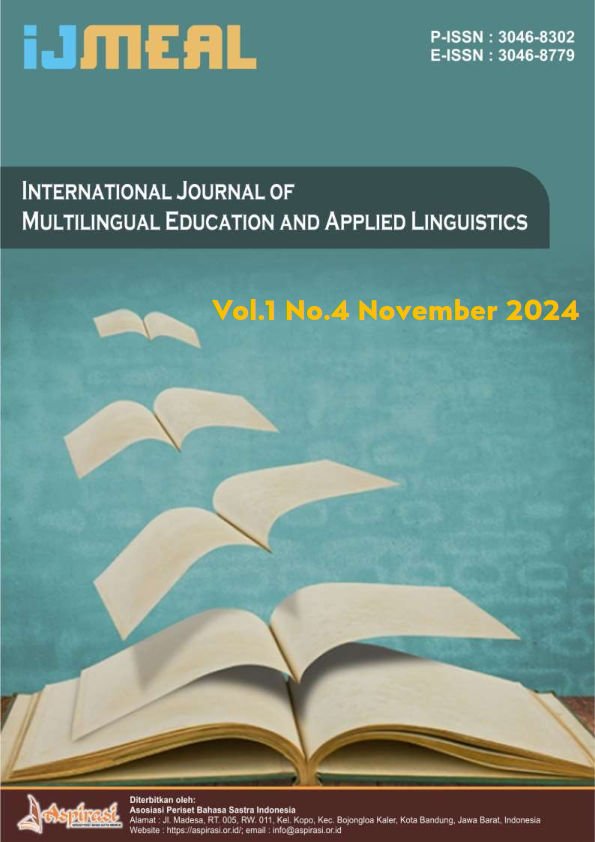Semantic Analysis in Story Diwa Night: Euphemism and Dysphemism
DOI:
https://doi.org/10.61132/ijmeal.v2i2.317Keywords:
Acehnese Language, Cultural Values, Dysphemism, Euphemism, Hikayat Malem Diwa, SemanticsAbstract
Hikayat Malem Diwa is one of the classic literary works in the Malay-Aceh tradition that is rich in language and cultural values. This story contains various language styles, especially euphemisms and dysphemisms, which reflect social norms, moral values, and conflict dynamics in Acehnese society. This study aims to identify and analyze the forms and functions of these two language styles, emphasizing their semantic and narrative roles. Using a semantic approach and qualitative descriptive methods, data were collected through quotations in the text with documentation techniques, then analyzed based on the context of meaning and use. The results show that euphemisms are often used to convey moral values and politeness, especially in terms of death, respect, and violation of norms. In contrast, dysphemisms appear in the context of violence and character conflict, strengthening the tension and emotion of the story. Overall, the use of these language styles reflects the rhetorical strategies and cultural values of the Acehnese people.
References
K. Allan and K. Burridge, Euphemism and Dysphemism: Language Used as Shield and Weapon. Oxford: Oxford University Press, 1991.
Department of Education and Culture of the Republic of Indonesia, Princess Bensu and Malim Dewa, in Folklore from Aceh, pp. 51–68, Cultural Media Development Project, Directorate General of Culture, 1976.
G. Hughes, An Encyclopedia of Swearing: The Social History of Oaths, Profanity, Foul Language, and Ethnic Slurs in the English-Speaking World. Armonk, NY: M.E. Sharpe, 2006.
J. Nasution, M. Pujiono, and M. Iqbal, "Verbal taboos in Acehnese language: Meaning, function, and euphemism," Randwick International of Education and Linguistics Science Journal, vol. 4, no. 1, pp. 58–70, 2023. [Online]. Available: https://doi.org/10.47175/rielsj.v4i1.642
K. Hasyim, N. Nurkamto, Sumarlam, and R. Santosa, "Lexical creation of euphemism and dysphemism in online media text on presidential election 2019," in Proc. 3rd Int. Seminar on Recent Language, Literature, and Local Culture Studies (BASA), Surakarta, Indonesia, 2019, pp. 1–5. [Online]. Available: https://eudl.eu/doi/10.4108/eai.20-9-2019.2296891
M. Ulfa, M. Mulyadi, M. Pujiono, and K. Nasution, "A natural semantic metalanguage approach on the meaning of animal taboo names in the Acehnese culture," Studies in English Language and Education, vol. 10, no. 1, pp. 1–15, 2023. [Online]. Available: https://doi.org/10.24071/siele.v10i1.31061
N. P. Ariani, N. L. S. Beratha, and N. L. N. S. Malini, "Semantic changes in translation of euphemism and dysphemism in Tempo magazine," Research and Innovation in Language Learning, vol. 3, no. 2, pp. 1–7, 2020. [Online]. Available: https://doi.org/10.33603/rill.v3i2.3255
M. Fitriani, H. Syarif, and D. Wahyuni, "Euphemism used by men and women in 'Indonesia Lawyers Club' TV One show: A language and gender perspective," English Language and Literature, vol. 8, no. 1, pp. 1–10, 2019. [Online]. Available: https://doi.org/10.24036/ell.v8i1.103269
A. Degaf, I. Nabila, and L. Amrullah, "The depiction of environmental preservation by Indonesian media: Study of euphemism and dysphemism," in Proc. 4th Annu. Int. Conf. on Language, Literature and Media (AICOLLIM 2022), Malang, Indonesia, 2023, pp. 1–5. [Online]. Available: https://doi.org/10.2991/978-2-38476-002-2_5
Z. Matondang, Sumarlam, and D. Purnanto, "A meaning component analysis of euphemism and dysphemism in Indonesian da’wah," International Journal of Linguistics, Literature and Translation, vol. 3, no. 9, pp. 58–65, 2020. [Online]. Available: https://doi.org/10.32996/ijllt.2020.3.9.6
B. T. P. U. Purba, U. Mono, and A. B. Perangin-angin, "An analysis of euphemism in political news in the Jakarta Post online newspaper," English Language and Literature, vol. 14, no. 1, pp. 1–10, 2025. [Online]. Available: https://doi.org/10.24036/ell.v14i1.130174
F. Ifrida and M. Huda, "Digital learning of euphemism and dysphemism based on Indonesian literary works," in Proc. Int. Conf. on Learning and Advanced Education (ICOLAE 2022), Surakarta, Indonesia, 2023, pp. 740–760. [Online]. Available: https://doi.org/10.2991/978-2-38476-086-2_65
W. Ayu, A. N. Aziza, A. Kusuma, and I. Nurul, "Disfemisme pada kolom komentar akun Instagram @rahmawatikekeyiputricantikka 23," Hastawiyata, vol. 4, no. 2, pp. 106–130, 2021. [Online]. Available: https://doi.org/10.21776/ub.hastawiyata.2021.004.02.02
Downloads
Published
How to Cite
Issue
Section
License
Copyright (c) 2025 International Journal of Multilingual Education and Applied Linguistics

This work is licensed under a Creative Commons Attribution-ShareAlike 4.0 International License.





